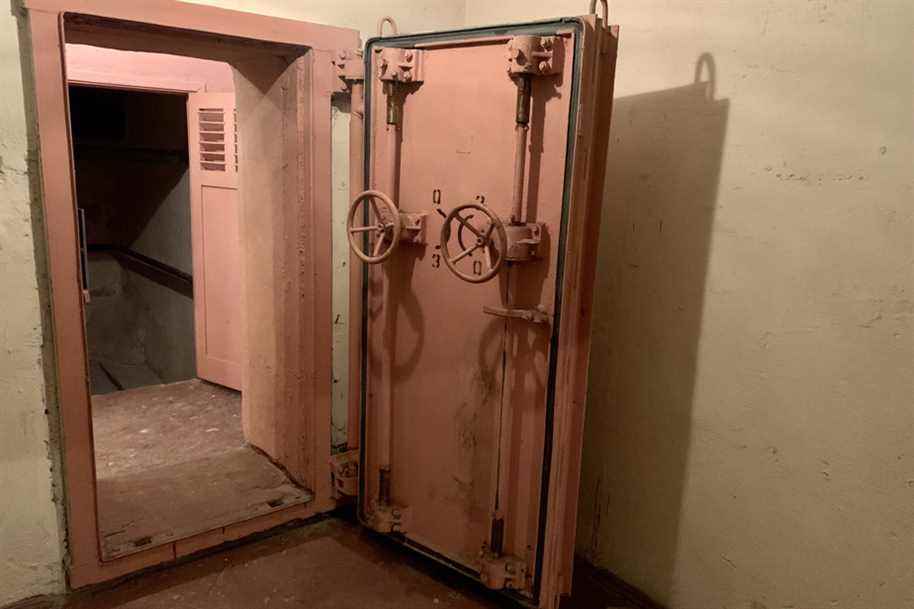(Kiev) Underground parking lots, metro stations, Cold War bunkers and even a strip club: the City of Kiev claims to have implemented a network of anti-bombing shelters capable of accommodating more than three million people, when Canada recommends its nationals to leave the Ukrainian capital because of regional tensions with Russia.
Posted at 6:00 a.m.
Crushed between huge residential towers from the Soviet era, the small municipal building does not look like much: a modest library, an assistance office for veterans, an unoccupied community police station, a public bulletin board. But the place harbors a secret in its bowels.
Civil servant Yevgen Gerasumov opens a door and reveals to The Press a staircase of about twenty steps. Below, under the ground, hides a bunker protected by two heavy hermetic armored doors. If the city is bombed, it is here that the continuity of essential services for this district of the capital, such as electricity supply, water supply and transport routes, must be ensured.

PHOTO VINCENT LAROUCHE, THE PRESS
The shelter is located under a small municipal office in which there is a library.
“In a depot like this, workers can take refuge and continue with their tasks,” says Gerasumov.
cold war relic
The shelter was built in 1982, in the midst of the Cold War, when the United States had a nuclear arsenal aimed at the USSR, of which Ukraine was a part. Today, with more than 100,000 Russian troops massed near the Ukrainian borders and a pro-Russian armed rebellion in the east of the country, the authorities have him ready, just in case.
The place is reserved primarily for municipal officials. The rooms are spartan, lit by the harsh light of bare bulbs. Offices, a few bunk beds in a rest room, toilets and cisterns filled with water. A ventilation system can be activated by force of arms, thanks to a crank. Wired internet and telephone connections ensure the link with the outside world. If the two exits are unusable, a small tunnel of one square meter allows an emergency evacuation.
-

PHOTO VINCENT LAROUCHE, THE PRESS
Emergency exit to a tunnel
-

PHOTO VINCENT LAROUCHE, THE PRESS
Shelter toilets
-

PHOTO VINCENT LAROUCHE, THE PRESS
Cisterns filled with water
1/3
The bunker can officially accommodate 350 people. By forcing a little, “we could reach 500 occupants”, affirms Mr. Gerasumov. Across the capital, 500 shelters are planned for essential service workers, and around 4,500 for the general population. These are often mixed-use underground structures, such as building basements and parking lots.
“The key bomb shelter in the city of Kiev will also be the metro, which – God forbid – will be ready to receive people in the event of an attack,” mayor Vitali Klitschko, a local television official, told local television. former professional boxer nicknamed “Dr Ironfist”.
Diplomatic talks are underway to ease tension in the region and Ukraine’s foreign minister reiterated on Wednesday that Russian forces massed near Ukraine’s borders were not sufficient for an invasion. But the Kyiv city administration still notes an interest of the population for the protective structures.

PHOTO VINCENT LAROUCHE, THE PRESS
Yevgen Gerasumov, civil servant and head of the shelter
“People call to find out where they are, how to get there, what to bring,” says Gerasumov.
“There is no panic”, he assures however.
An interactive map has been published on the internet and makes it possible to instantly find the nearest shelter. If necessary, sirens scattered across the City would tell citizens to take shelter.
On Velyka Vasylkivska Street, near the Kiev planetarium, an arrow painted on the wall indicates the presence of shelter number 102 in a basement, as well as the number to dial to have it opened if necessary. The place is normally occupied by the stripper bar Penthouse, but the owner must let everyone in in case of emergency.

PHOTO FROM CABARET PENTHOUSE WEBSITE
The Penthouse bar, in the basement of a building in Kiev, is part of the municipality’s bomb shelters.
A few controversies have erupted in the media about incorrect addresses or phone numbers, barricaded shelters that have become inaccessible, errors in the map. The city says it conducts inspections to ensure infrastructure will live up to expectations.
Peaceful resolution sought
Meanwhile, the state of the situation in the region pushes the Canadian government to invite its nationals to leave Ukraine. “If you are in the country, you should [partir] by [vols] as long as they are available,” the Canadian Embassy in Kyiv said on Tuesday.
The United States meanwhile announced the movement of additional troops to Europe on Wednesday. About 1,000 military personnel who were in Germany will be sent to Romania, and another 2,000 military personnel will depart from the United States for temporary deployment in Poland and Germany, according to Washington’s plan.
Moscow immediately denounced an “unjustified, destructive maneuver, increasing military tensions and reducing the field for political decisions”, according to the Interfax agency. Russia has long called for a halt to NATO expansion towards its borders and an assurance that Ukraine will not join the military alliance.
Separately, British Prime Minister Boris Johnson had a conversation with President Vladimir Putin about the situation in Ukraine on Wednesday. They pledged to seek “a peaceful resolution” to the crisis.
“Leaders have agreed that worsening is in no one’s interest,” the UK government said.
Learn more
-
- 2.9 million
- Population served by Kyiv administration
Ukrainian State Statistical Service
- 140km
- Road distance from Kiev to the border of Belarus, where Russian troops are stationed
Google Maps

